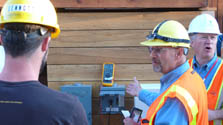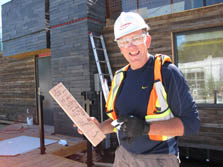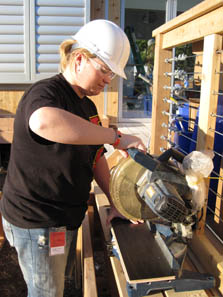
Click photo to view high-resolution image.

Refract House is the first house in Solar Decathlon history to be connected with a microgrid. Team California member Tim Sennott verify the voltage with site operations personnel Byron Stafford and Mike Coddington.
(Credit: Angel Borrego Cubero/U.S. Department of Energy Solar Decathlon)

Team Alberta crewmember Mike Blackwell takes lunch orders on a piece of wood.
(Credit: Annie Coghill/U.S. Department of Energy Solar Decathlon)

Kasandra Dickerson cuts sections of bamboo board used in the radiant flooring of Iowa State's Interlock House.
(Credit: Annie Coghill/U.S. Department of Energy Solar Decathlon)
Solar Decathlon 2009
Daily Journal - October 5, 2009
At 6:09 p.m. Monday, Our First Grid Connection
Team California's Refract House is the first Solar Decathlon house ever to be connected with a microgrid. Site operations staff Byron Stafford and Mike Coddington flipped the switch as the team looked on. The first reading was nice and strong, registering 123 volts. Byron and Mike then headed down the village to the Rice house, which was second on the list for grid connection. We hope to have 11 connected with the grid tonight.
We are three days away from being competition-ready. Before that can happen, all the houses must pass a series of inspections not only for competition purposes but also to ensure the safety of the students and public. In advance of their arrival on the Mall, the houses were inspected at their local jurisdictions. What they undergo here is a secondary set of inspections by our event staff.
Solar Decathlon building inspectors are responsible for ensuring the compliance of electrical and mechanical systems, eliminating potential fire hazards, and verifying the structural integrity of the houses before they host event visitors. Although the houses must comply with current building codes, Inspection Officer Tom Meyers believes the work being done by the student teams is about 10 years ahead of what is used by today's architects, engineers, and contractors. Here are some examples:
In the structural rafters and I-joists of Refract House, Team California uses bamboo, an alternate material not currently in the building code.
Team Germany incorporates a building component—drywall with phase-change material inside—that is available in Europe but not yet seen in the United States.
Day five was another incredibly busy day. Kudos to Team Alberta. It has already passed multiple inspections with flying colors. Team member Dolores Bender-Graves says the team is excited to see the house fully assembled. Installed for the first time here in D.C., the rundlestone parapets, a primary design feature on the north side and roof, complement the recovered barn wood on the house's exterior.
First-time entrant Iowa State quietly made progress all weekend. Faculty Advisor Ulrike Passe complimented the student-led team's organization and troubleshooting abilities. Now the focus is on passing final inspections and preparing for VIP visits. The team has tremendous university support and is expecting a six-person contingent from the school—including its president, provost, and several deans—to attend the Opening Ceremony on Oct. 8.
At this point, we are about halfway through the inspection process. Tom Meyers believes we are ahead of schedule compared with 2007 and is confident all the teams will be ready on time.
